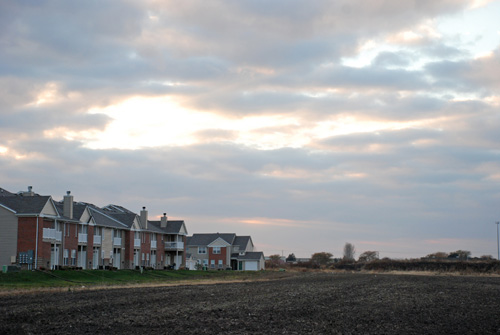C-U urban expansion threatens farmlands

November 16, 2007
Champaign and Urbana residents driving down Prospect Avenue to shop for groceries from Meijer or Wal-Mart 10 years ago would have been confronted with green farmland instead of the now-bustling retail strip, said Kirk Builta, information director for the Champaign Farm Bureau.
“The farther north you go, that’s where the farmland meets,” Builta said, “There was nothing there on the north side of the interstate.”
Over time, urban sprawl has spread into former farmland and increased the size of Champaign County.
“What’s happening with urban sprawl is they’re taking away good farmland for urban development,” Builta said.
Farmers surrounding the city limits have been protesting the outward growth and have asked for better planning from the government.
Get The Daily Illini in your inbox!
Though Champaign County has worked to develop a plan, no comprehensive policy has been decided, said Brad Uken, Champaign County Farm Bureau manager.
The rate of expansion in Champaign County is outpacing the rate of population increase.
“I think you’ve got to look at population growth in Champaign County versus acres used to developments,” Uken said. “Developments have gone up dramatically in comparison to population.”
The bureau believes in compact and continuous development with an emphasis on development within existing urban areas rather than expanding into farmland, he said.
“In no way does development need to stop, but there needs to be planning for development of agriculture,” Uken said.
Hal Barnhart, a Champaign County farmer with land south of Bondville, which is 10 miles southwest of Champaign, said he is troubled by the trend of urban development.
“Where I live you can see the west end of Champaign,” he said.
Barnhart said he understands the incentive for some farmers to sell their land into development.
“A lot of the times it’s a trade. You get four or more acres for the price of one. There’s an economic benefit from it. The long term results are not good though,” he said.
Barnhart favors infill, which focuses on further developing existing urban areas.
The alternative to infill is greenfield when new property is built on the outskirts of town.
“A lot of the single-family homes that are being built are on the outside of town,” said Jeff Marino, a planner for the city of Champaign.
Infill makes it more difficult to get developers to build in existing urban areas because of desirability and overall cost, he said.
“It’s hard to develop in economies of scale (in the middle of town).” Marino said. “They can’t buy an 80-acre tract of land and build houses on it. In the middle of town it can be a lot more time consuming.”
The city of Champaign has built incentives into its planning to increase the desirability to build in the urban areas for developers.
“Champaign has a comprehensive plan that guides the city,” Marino said, “The zoning map has areas outside of the city designated for growth and areas recommended for no growth.”
It also has a redevelopment incentive program, which gives a 10 percent discount for any permanent infrastructure improvement on existing structures in urban areas, he said.
“Growth is going to occur, but what we can control is where it happens,” Marino said. “Some farmland is going to be turned into urbanized areas. What you want to make sure is that land is maximized.”
The city of Urbana also has a comprehensive plan to encourage development of existing urban areas rather than expanding into farmland.
“We are guided by our city’s comprehensive plan which was adopted in 2005,” said Robert Myers, planning manager for Urbana. “As part of the plan, we have policies forcing infill and avoiding expanding into farmland.”
The west Urbana neighborhood was designated as one of 10 great neighborhoods in America in early October by the American Planning Association, a professional association advocating excellence in planning. It was the only Midwestern city on the list, Myers said.
Some concerned members of the Champaign community feel greenfield building and urban sprawl should be better controlled.
“So many other countries don’t do what we do,” said Misty Barron, Champaign resident. “So much is wasteful in the way we plan our cities.
“It’s probably cheaper to buy land and start over, but in the long run I don’t think it’s necessarily as cost effective to our resources and community members.”
Resources for new developments are not limitless, said Barnhart.
“Once you lose the resource, you’ve lost the resource,” he said. “We now have to plan as though we’re going to be here for while. Maybe we should think 1,000 years in advance.”






